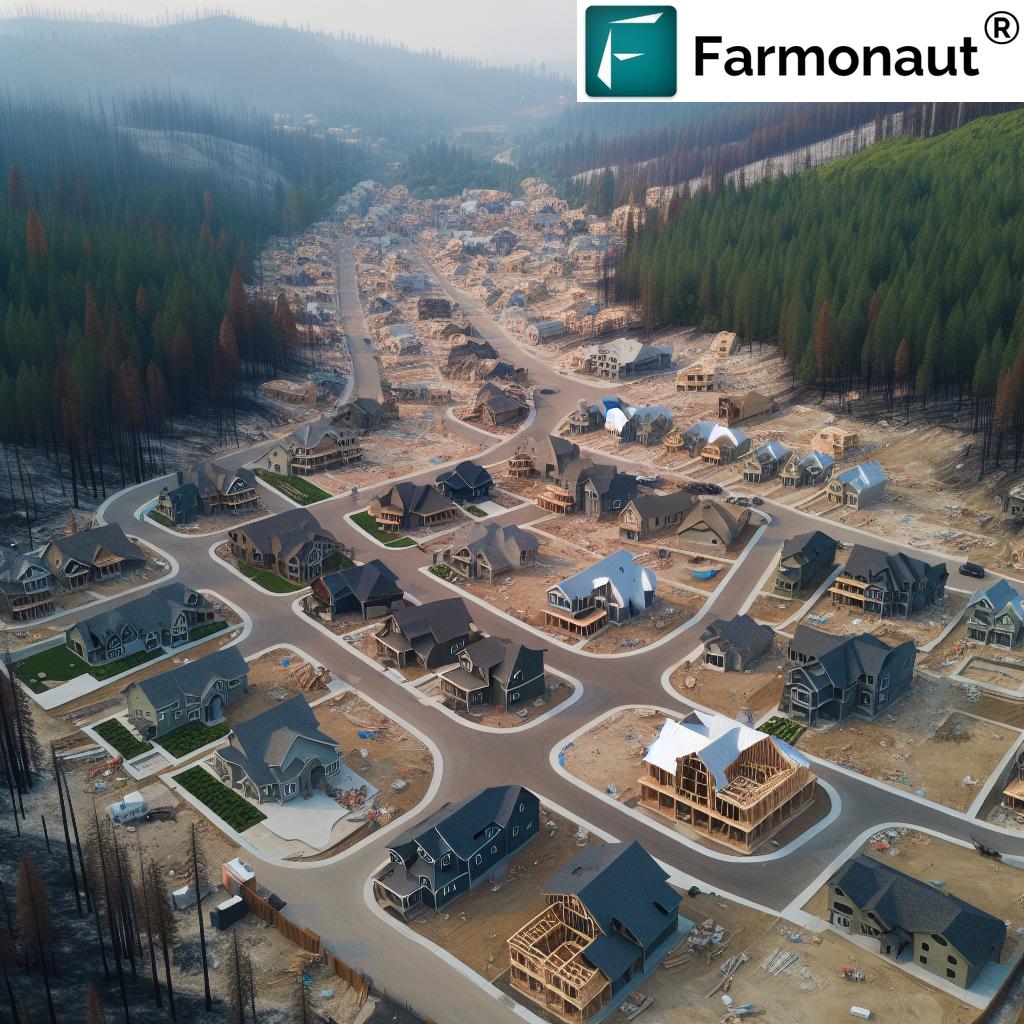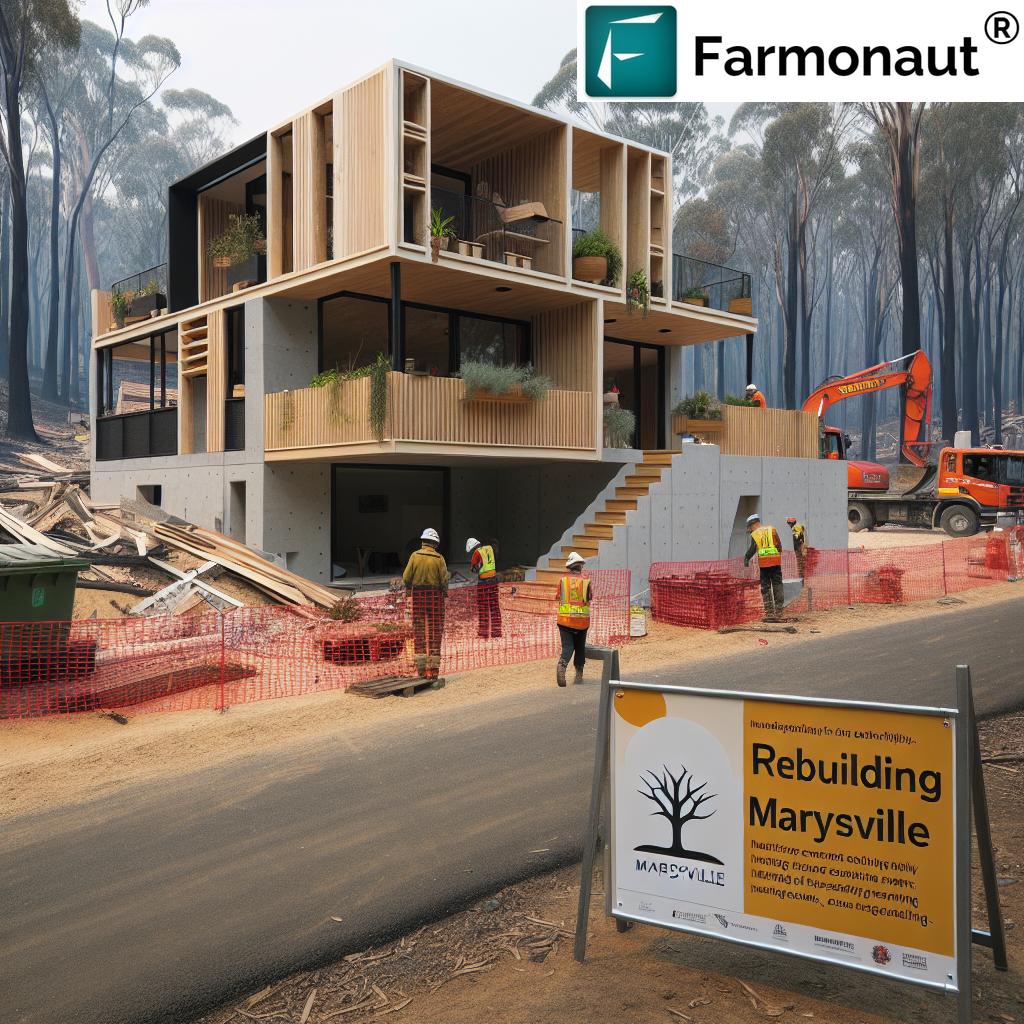Rebuilding Marysville: Lessons from Australia’s Black Saturday Bushfire Recovery
“The 2009 Black Saturday bushfires in Australia destroyed 95% of Marysville’s buildings, leaving only 14 structures standing.”
In the aftermath of one of Australia’s most devastating natural disasters, the small town of Marysville faced an unprecedented challenge. The Black Saturday bushfires of 2009 not only razed the town to the ground but also left a community grappling with loss, trauma, and the daunting task of rebuilding. As we delve into Marysville’s journey from destruction to recovery, we uncover valuable lessons in disaster management, community resilience, and the complexities of rebuilding in high-risk areas.
The Day That Changed Everything
On February 7, 2009, Marysville, a picturesque town nestled in the forests of Victoria, Australia, faced an inferno of unimaginable proportions. As temperatures soared and winds raged, a perfect storm of conditions created what would become known as the Black Saturday bushfires. The devastation was swift and merciless, leaving the community in shock and the landscape transformed.

In the immediate aftermath, the scale of the disaster became clear:
- 39 lives lost in Marysville alone
- 536 out of 550 buildings destroyed
- A community of over 500 residents displaced
The fire’s ferocity caught many off guard, including long-time resident David Barton, who initially believed that “entire towns don’t burn down.” This widespread underestimation of the fire risk would later become a crucial point of reflection in the recovery process.
The Immediate Response: Challenges and Controversies
In the days and weeks following Black Saturday, Marysville faced immediate challenges that would shape its recovery journey:
- Access restrictions: Authorities blocked off the town for weeks, preventing residents from returning to recover personal belongings or attend to deceased pets. This decision, while made for safety reasons, exacerbated the emotional trauma for many survivors.
- Temporary housing: The government quickly established ‘Temporary Village’ to house displaced residents. While providing shelter, this cramped living arrangement added to the stress and tension within the community.
- Government promises: Then-state premier John Brumby vowed to restore Marysville’s commercial heart, setting expectations for a swift recovery.
These initial responses, while well-intentioned, highlighted the complex balance between safety, emotional needs, and the desire for rapid recovery.
The Great Debate: To Rebuild or Relocate?
As the dust settled, a fundamental question emerged: Should Marysville be rebuilt in its original location, or was it time to consider relocation? This debate encapsulated the tension between emotional attachment to place and scientific recommendations for safety.
Arguments for rebuilding:
- Emotional connection to the land and community
- Economic importance of Marysville as a tourist destination
- Belief in improved fire-resistant building techniques
Arguments against rebuilding:
- High inherent fire risk due to surrounding forests
- Limited escape routes in case of future fires
- Potential for putting future residents and emergency services at risk
Planning expert Roz Hansen argued strongly against rebuilding, stating, “Some towns you can never protect from another Black Saturday-style fire. Marysville is one such town.” This perspective, while based on risk assessment, faced significant pushback from those emotionally invested in the town’s future.
The Decision to Rebuild: A Community Divided
Despite expert recommendations, the decision to rebuild Marysville was ultimately driven by a combination of community desire, political considerations, and economic factors. This decision set the stage for a complex and often contentious recovery process.
“Marysville’s population dropped from 519 to 223 after the Black Saturday bushfires, a 57% decrease in residents.”
Implementing New Safety Measures
With the decision to rebuild came the critical task of implementing new safety measures to reduce future fire risks. Key initiatives included:
- Revised building codes: Stricter regulations for fire-resistant materials and designs
- Improved warning systems: Enhanced early warning and evacuation procedures
- Vegetation management: New guidelines for maintaining safe distances between buildings and forests
These measures aimed to create a more resilient Marysville, capable of withstanding future fire threats. However, their implementation often faced challenges, including increased costs and debates over aesthetic changes to the town’s character.
The Psychological Impact: Trauma and Recovery
The Black Saturday bushfires left deep psychological scars on Marysville’s residents. Understanding and addressing this trauma became a crucial aspect of the recovery process.
- Post-Traumatic Stress Disorder (PTSD): Many residents, including David Barton, reported symptoms of PTSD, anxiety, and depression.
- “Post-Disaster Attachment Trauma”: Barton’s research identified a specific form of trauma related to prolonged separation from one’s home and community after a disaster.
- Community support: The establishment of mental health services and support groups played a vital role in the healing process.
The psychological recovery of Marysville’s residents underscored the importance of mental health considerations in disaster recovery planning.
Rebuilding the Physical Landscape
The physical reconstruction of Marysville presented both opportunities and challenges:
- New architectural styles: Modern, fire-resistant designs sometimes clashed with the town’s historic character.
- Infrastructure improvements: Rebuilt roads, water systems, and public buildings incorporated advanced safety features.
- Green spaces: New parks and community areas were designed to serve as both recreational spaces and potential fire breaks.
The rebuilt Marysville emerged as a blend of old and new, with its transformed landscape serving as a constant reminder of both loss and resilience.

Economic Recovery and Transformation
Rebuilding Marysville’s economy was crucial for the town’s long-term sustainability. Key aspects of this process included:
- Tourism revival: Efforts to attract visitors back to the region, emphasizing Marysville’s natural beauty and resilience
- Small business support: Government grants and programs to help local businesses reestablish themselves
- New economic opportunities: Exploration of new industries and markets to diversify the local economy
The economic recovery of Marysville demonstrated the importance of adaptability and innovation in post-disaster scenarios.
Lessons Learned: A Blueprint for Future Disaster Recovery
Marysville’s journey offers valuable lessons for communities facing similar challenges:
- Risk assessment and planning: The importance of thorough, science-based risk assessments in decisions about rebuilding in high-risk areas
- Community involvement: The critical role of community engagement in the recovery process, balancing local desires with expert recommendations
- Psychological support: The need for long-term mental health resources and support systems for disaster survivors
- Adaptive rebuilding: The value of incorporating new safety measures and technologies while respecting community character
- Economic diversification: The importance of building a resilient, diverse local economy to support long-term recovery
The Ongoing Challenge: Climate Change and Future Fire Risks
As Marysville continues to recover and adapt, the specter of climate change looms large. Increasing temperatures and more frequent extreme weather events pose ongoing challenges to the town’s long-term safety and sustainability.
Efforts to address these challenges include:
- Continued research into fire behavior and prevention strategies
- Investment in advanced early warning systems and firefighting technologies
- Community education programs on fire preparedness and climate resilience
These ongoing efforts underscore the reality that disaster recovery is not a one-time event but an ongoing process of adaptation and preparedness.
Marysville Today: A Testament to Resilience
Today, Marysville stands as a testament to human resilience and the power of community. While the scars of Black Saturday remain, both in the landscape and in the hearts of its residents, the town has emerged stronger and more prepared for future challenges.
Key features of the rebuilt Marysville include:
- A mix of new and returning residents, bringing fresh energy to the community
- State-of-the-art fire safety systems and building designs
- A renewed focus on sustainable living and environmental stewardship
- A thriving tourist industry that honors the town’s history while embracing its new identity
Conclusion: The Ongoing Journey of Recovery and Preparedness
The story of Marysville’s recovery from the Black Saturday bushfires is far from over. It serves as a powerful reminder of the complexities involved in rebuilding after a major disaster, especially in the face of ongoing environmental challenges.
As we reflect on Marysville’s journey, we are reminded of the importance of:
- Balancing emotional attachment to place with scientific risk assessment
- Prioritizing community mental health and well-being in disaster recovery
- Adapting to changing environmental conditions while preserving community identity
- Continuous learning and preparation for future challenges
Marysville’s experience offers invaluable lessons for communities worldwide facing the increasing threats of climate-related disasters. It reminds us that recovery is not just about rebuilding structures, but about rebuilding lives, communities, and hope for the future.
FAQs
- What caused the Black Saturday bushfires?
The Black Saturday bushfires were caused by a combination of extreme heat, drought conditions, and high winds. Some fires were sparked by fallen power lines, while others were deliberately lit. - How long did it take for Marysville to rebuild?
The initial rebuilding phase took several years, with major infrastructure mostly restored within 5 years. However, the recovery process is ongoing, with continued developments and adaptations. - Were there any changes to fire management policies after Black Saturday?
Yes, significant changes were made to bushfire management policies, including improved early warning systems, stricter building codes in fire-prone areas, and enhanced emergency response protocols. - How has climate change affected bushfire risk in Australia?
Climate change has increased the frequency and intensity of extreme weather events in Australia, leading to longer fire seasons and more dangerous fire conditions. - What support was provided to Marysville residents during the recovery process?
Residents received various forms of support, including temporary housing, financial assistance, mental health services, and community rebuilding programs.
Marysville Recovery Timeline and Milestones
| Year | Event/Milestone | Impact | Lessons Learned |
|---|---|---|---|
| 2009 | Black Saturday Bushfires | 95% of town destroyed, 39 lives lost | Importance of early warning systems and evacuation plans |
| 2010 | Implementation of new fire-resistant building codes | Increased construction costs, improved safety standards | Balancing safety with affordability in rebuilding efforts |
| 2011 | Opening of new community center | Provided central gathering space for residents | Importance of community spaces in fostering recovery |
| 2013 | Completion of major infrastructure rebuilding | Restored basic services and improved town resilience | Need for long-term planning in disaster recovery |
| 2015 | Launch of new tourism campaign | Boost to local economy, return of visitors | Economic diversification crucial for long-term recovery |
| 2019 | 10-year anniversary commemorations | Reflection on progress and ongoing challenges | Recovery is a long-term process requiring ongoing support |
As we conclude our exploration of Marysville’s recovery journey, it’s clear that the lessons learned extend far beyond the boundaries of this small Australian town. The experiences of Marysville offer valuable insights for communities worldwide facing the increasing threats of climate-related disasters.
For those interested in learning more about innovative approaches to environmental monitoring and sustainable agriculture, consider exploring the solutions offered by Farmonaut. While not directly related to bushfire recovery, Farmonaut’s satellite-based farm management tools provide valuable insights for land management and environmental monitoring.
For mobile users:
For developers interested in integrating environmental data into their own applications, check out Farmonaut’s API and API Developer Docs.
Earn With Farmonaut: Affiliate Program
Earn 20% recurring commission with Farmonaut’s affiliate program by sharing your promo code and helping farmers save 10%. Onboard 10 Elite farmers monthly to earn a minimum of $148,000 annually—start now and grow your income!
As we face an uncertain future with increasing environmental challenges, the story of Marysville reminds us of the resilience of the human spirit and the power of community in overcoming even the most devastating disasters. It serves as both a warning and an inspiration, urging us to prepare for the challenges ahead while never losing sight of the strength we find in unity and perseverance.



